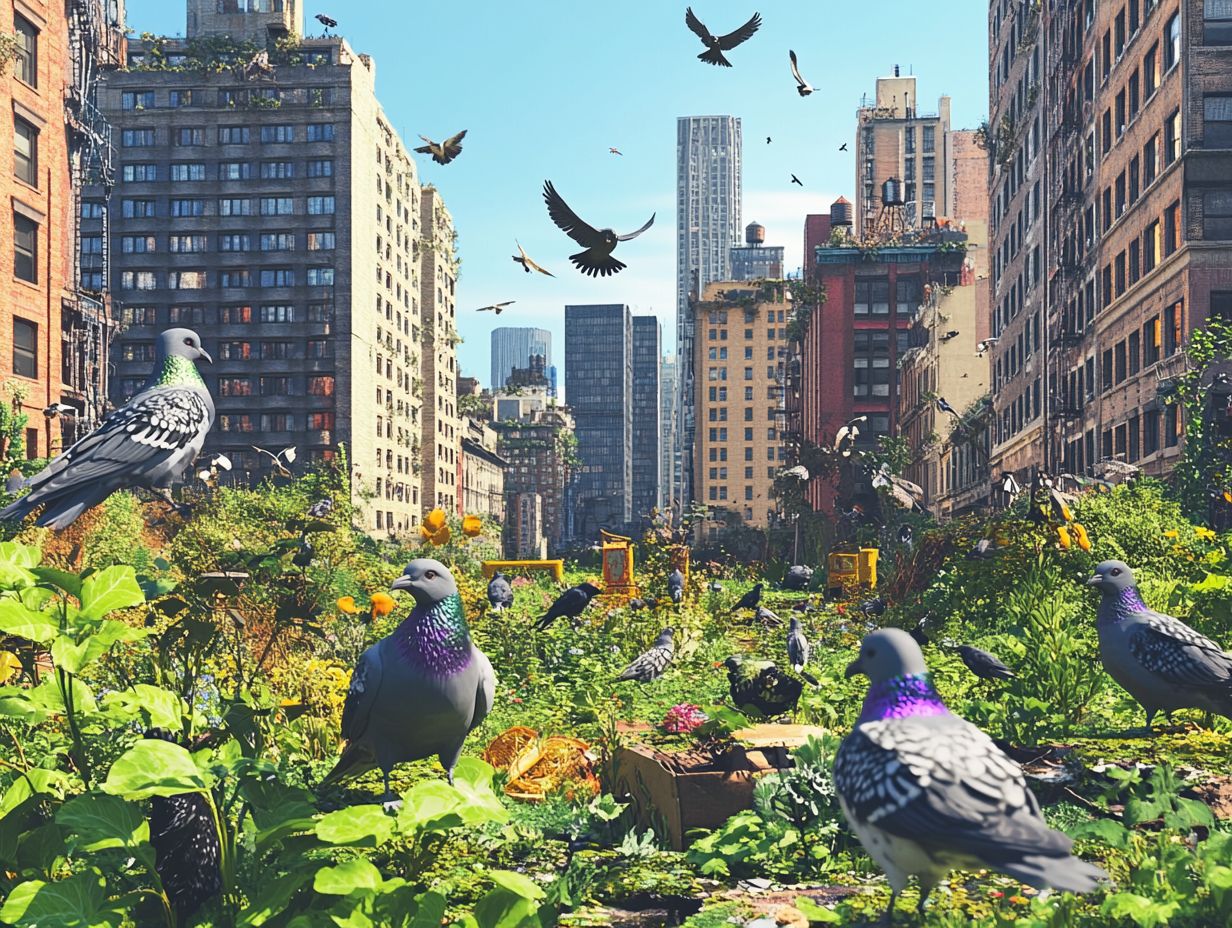Urban environments are vibrant ecosystems teeming with unexpected residents: birds that have uniquely adapted to thrive amid the concrete and chaos. This article delves into the fascinating adaptations that allow these avian inhabitants to flourish in cities, exploring their physical traits and behavioral shifts.
We will examine how they navigate the challenges of urban life, the dual impact of urbanization on their populations, and the conservation efforts aimed at protecting their habitats.
Join us as we uncover the secret lives of urban birds and the remarkable resilience they demonstrate in our ever-changing landscapes.
Defining Urban Birds and their Environments

Urban birds are species that have adapted to life in cities and metropolitan areas. These common birds thrive in urban habitats such as parks, gardens, rooftops, and city streets. They play a significant role in urban biodiversity, and their ecological functions have been modified to suit the unique landscapes of cities. Their adaptations to urban environments have profoundly influenced their foraging, nesting, and population behaviors, allowing them to flourish amidst the challenges posed by urbanization.
The term “urban birds” refers to species that have effectively adjusted to urban ecosystems. These species have adapted their life strategies to the specific biotic and abiotic conditions found in urban areas. Common examples of urban birds include crows, sparrows, pigeons, and starlings. While their ecological niches may differ from those in natural habitats, they remain essential for their interactions with the urban environment and for the maintenance of urban biodiversity.
Understanding the definition and significance of urban birds is crucial in our daily lives, as it enables us to appreciate their role in urban biodiversity and their ecological contributions to both cities and the natural environment. Moreover, recognizing the importance of urban birds is critical for conserving their habitats and promoting biodiversity within urban centers.
Like many wildlife species, urban birds have modified their foraging behaviors to adapt to the lack of natural habitats. Urban landscapes often do not meet their foraging needs, leading some species, such as house finches and starlings, to utilize human structures for food sources and nesting sites. For example, house finches frequently scavenge for food scraps at drive-in restaurants, while starlings are known to feed on insects attracted to lights at office buildings and gas stations.
One of the most important ecological roles played by urban birds is in pest control. Many urban birds hunt insects that would otherwise thrive in urban environments, such as cockroaches and mosquitoes. Additionally, other urban bird species are vital for seed dispersal and pollination of flowering plants, both of which are essential for the health of urban flora. Urban birds also contribute services like soil aeration through their digging and provide shelter for other animals through their nesting behaviors. Overall, urban birds are a key component in maintaining biodiversity within cities, significantly contributing to the health of both urban and natural ecosystems.
Adaptations of Urban Birds
The adaptations of urban birds exemplify their evolutionary journey toward survival in challenging urban landscapes. As urbanization continues, these birds display unique physical and behavioral characteristics that enhance their resilience and ability to thrive amid environmental pressures such as pollution, habitat fragmentation, and noise.
For instance, urban wildlife like sparrows and finches have shown changes in their nesting adaptations and foraging strategies, enabling them to utilize available food sources and navigate their surroundings effectively.
Physical and Behavioral Changes

Physical and behavioral changes in urban birds are crucial for their survival and adaptation. These birds develop unique traits, such as smaller body sizes and altered plumage, to cope with urban conditions. Their behavioral flexibility enables them to adapt quickly to new challenges and food sources. For instance, urban sparrows often exhibit modified foraging strategies that allow them to thrive in environments characterized by increased human interaction and competition from other species.
Research has also demonstrated that urban environments lead to changes in vocalization patterns; some species adapt their songs to overcome the noise generated by traffic and human activity. Additionally, behavioral shifts, such as increased sociability, can be observed, with birds often gathering in larger flocks to maximize foraging efficiency and enhance protection from predators.
These adaptations not only improve their interactions with other species within the urban ecosystem but also enhance their overall fitness, enabling them to exploit resources more effectively and navigate the complexities of their altered habitats. Such studies underscore the remarkable resilience and adaptability of urban birds, making them a focal point of urban ecology research.
Survival Strategies in Urban Environments
Survival strategies are essential for urban birds, as they face numerous threats to their existence. To cope with challenges such as habitat loss, pollution, and human activities, urban birds develop various strategies.
Many species utilize urban migration patterns as a response to these threats, adjusting their movement according to seasonal changes and the availability of resources. Additionally, urban renewal projects that alter habitats pose significant risks to their survival, making the restoration of bird habitats crucial.
Overcoming Obstacles and Challenges

Urban birds encounter heightened competition while searching for food and safe nesting sites. Additionally, they face threats from urban predators such as feral cats, larger birds of prey, and even other bird species. Their ability to adapt their behavior and establish territories is crucial for maintaining their populations amid these challenges. Understanding predator-prey relationships is essential for grasping the balance of urban ecosystems and the survival tactics employed by various bird species.
As urban birds navigate limited resources and a wide array of competing species, they must find suitable food sources and nesting sites. Urban landscapes, with their tall buildings and bustling streets, offer few nesting options, forcing birds to construct their nests in precarious or dangerous locations. Breeding and raising young can be particularly perilous, as these birds are exposed to predators, traffic, and the daily hustle and bustle of urban life.
The dangerous environments in cities make it even more vital for urban birds to establish territories, providing them with a safe space to access the resources necessary for survival. As a result, numerous unique behaviors have developed among urban bird species. Many have adjusted their feeding schedules to forage when fewer humans are present, while others have modified their calls to attract potential mates or to signal that a territory is already occupied.
Impact of Urbanization on Bird Populations
Urbanization significantly impacts bird populations, resulting in both positive and negative effects on biodiversity and species diversity. As cities expand, natural habitats become fragmented, disrupting the environments that many birds rely on for food and nesting sites.
However, urban areas can also serve as biodiversity hotspots, creating unique ecological niches that allow certain bird species to thrive in anthropogenic habitats.
Positive and Negative Effects

Urbanization presents both benefits and drawbacks that influence avian biodiversity as birds adapt to their changing habitats. Urban green spaces offer essential food sources and nesting opportunities, but they also lead to increased competition among species. This highlights the dual nature of urbanization’s impact on the environment and underscores the importance of urban planning and wildlife conservation in maintaining the balance of nature.
The incorporation of parks, community gardens, and green roofs can significantly enhance habitat options for various bird species, enabling them to thrive in urban settings. However, as the number of species in these areas increases, so does the competition for resources such as food and nesting space, which may adversely affect more sensitive species.
To preserve ecological balance, cities must maximize green space and engage residents in local conservation efforts. When community members participate in habitat restoration and awareness programs, they contribute to creating a more sustainable environment for urban wildlife.
Conservation Efforts for Urban Birds
Urban bird conservation is essential for maintaining biodiversity and ensuring the survival of various species in urban environments. As rapid urbanization continues, raising public awareness and encouraging community involvement in bird conservation efforts have become increasingly important.
Implementing urban wildlife management strategies, such as habitat restoration and the creation of ecological corridors, can help mitigate the negative effects of urbanization on bird populations.
Protecting and Preserving Urban Bird Habitats
Protecting and preserving urban bird habitats is crucial for the health of avian populations and the ecological balance of city landscapes. Strategies such as wildlife corridors and urban green spaces enhance habitat availability and support species interactions. These initiatives are essential for improving biodiversity and helping urban birds adapt to increasingly fragmented environments.
Urban planners and conservationists can take practical steps to incorporate natural elements into metropolitan designs, thereby better connecting bird species. Creating green roofs, vertical gardens, and urban forests provides additional habitats that simulate natural environments. Establishing ecological corridors that link parks, riverbanks, and other green spaces facilitates the movement of birds and increases the likelihood of successful breeding and foraging.
This holistic approach benefits bird populations while enhancing urban life, making cities more livable and providing residents with opportunities to develop a greater appreciation of nature.
